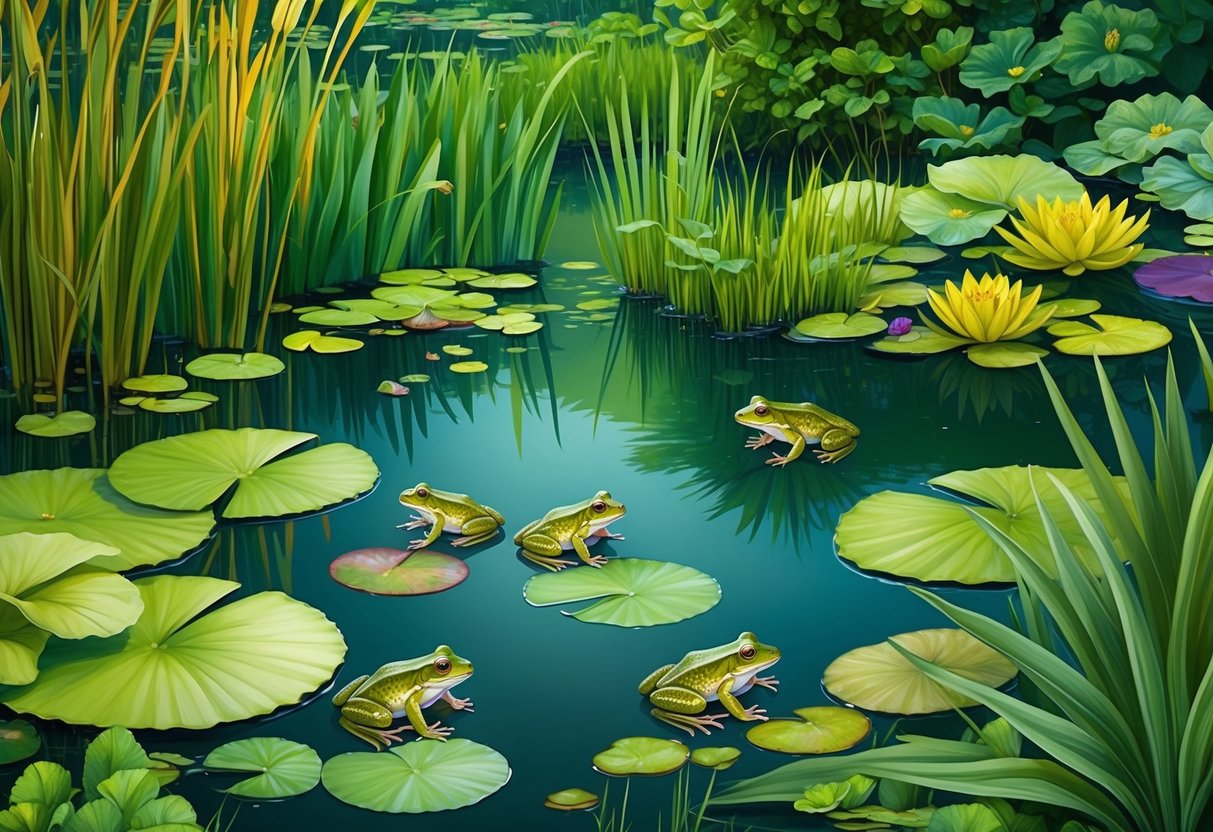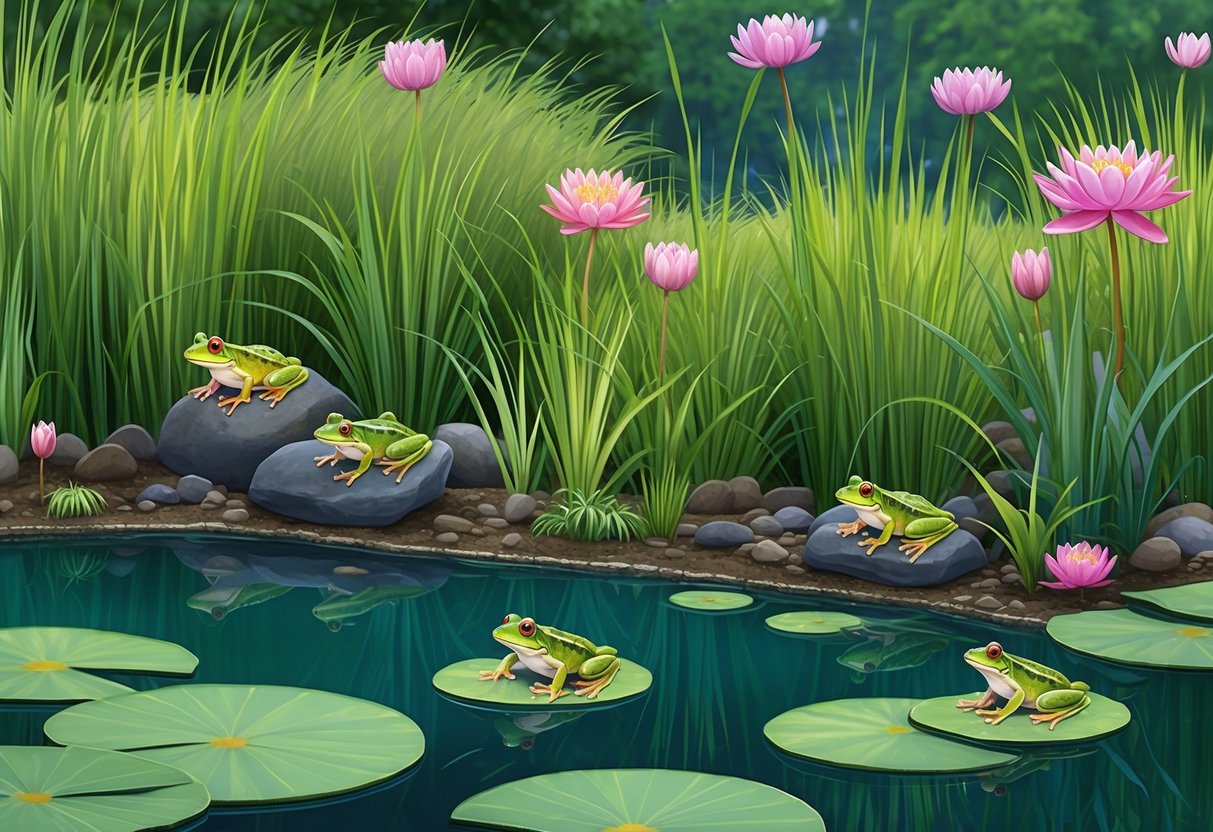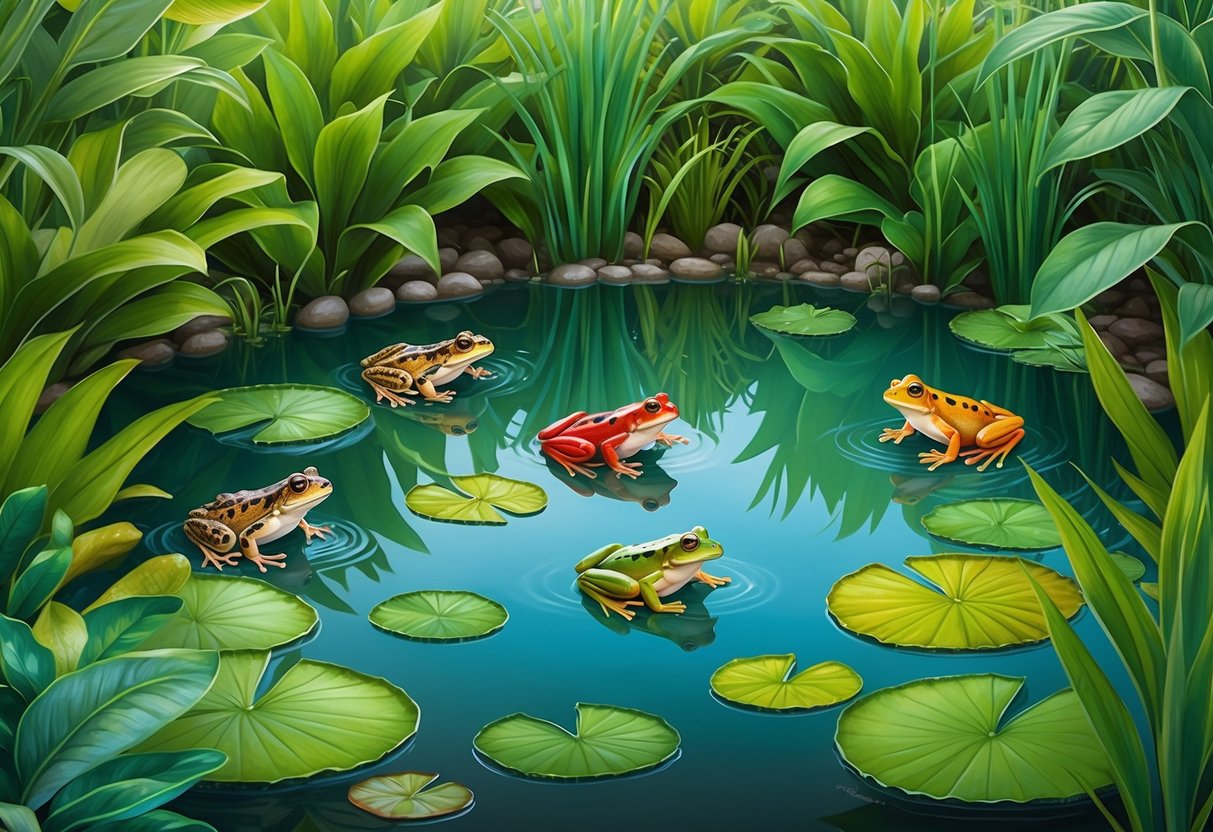The Best Plants For Attracting Frogs To Your Pond: Green Magnets for Amphibian Friends
Frogs are fun and helpful visitors to any garden pond. They eat bugs and make cool sounds. If you want more frogs in your pond, you need the right plants.
Plants that attract frogs include water lilies, pickerel rush, and flag irises.
These plants give frogs places to hide, rest, and hunt. They also make your pond look nice.
Some plants grow in the water, while others grow around the edges. This mix creates a comfy home for frogs.
Picking the right plants is just one part of making a frog-friendly pond. You also need clean water and places for frogs to get in and out easily. With the right setup, you’ll soon hear lots of happy frog sounds in your yard.
Key Takeaways
- Water plants provide shelter and hunting spots for frogs
- A mix of in-water and edge plants creates the best frog habitat
- Clean water and easy access are important for attracting frogs to your pond
Understanding Frog Habitats
Frogs need specific conditions to thrive in your pond. Clean water and hiding spots are key to creating a frog-friendly environment.
Importance of Water Quality
Good water quality is vital for frogs. They breathe and drink through their skin, so clean water is a must.
Avoid using chemicals in your pond or nearby areas. These can harm frogs.
Add plants to your pond to help keep the water clean. Water lilies and pickerel rush are great choices. They filter the water and provide places for frogs to rest.
You should also test your pond water regularly. Keep pH levels between 6.5 and 7.5. This range is ideal for most frog species.
Shelter and Hiding Spots
Frogs need places to hide from predators and the sun. Plantain lilies, also called hostas, have big leaves that make great hiding spots. Put these around the edges of your pond.
Floating plants like water lilies give frogs a place to sit on the water. They also provide shade, which keeps the water cool.
Add rocks and logs near the pond. Frogs can bask on these to warm up. They also offer shelter from rain and wind.
Leave some tall grass or native plants near the pond. These give frogs a safe path to and from the water.
Creating the Perfect Pond Environment
A frog-friendly pond needs the right size, plants, and water quality. These elements work together to make frogs feel at home in your backyard oasis.
Pond Size and Depth
Your pond should be at least 6 feet wide and 2 feet deep. This size gives frogs enough space to swim and hide. A larger pond is even better, as it can support more frogs and other wildlife.
Make sure your pond has sloped sides for easy access. Frogs need to get in and out of the water easily. A gradual slope from shallow to deep is ideal.
Include some shallow areas around the edges. These spots are perfect for frogs to sit and soak up the sun.
Plant Selection
Choose a mix of plants to create a diverse habitat. Water lilies are great for attracting frogs. They provide floating leaves for frogs to rest on and shade for the water below.
Add some marginal plants around the edges of your pond. These plants grow in shallow water and provide cover for frogs. Good choices include:
- Cattails
- Rushes
- Irises
Don’t forget about plants for the land around your pond. Hostas offer great ground cover and hiding spots for frogs.
Maintaining Healthy Water
Clean water is key to a frog-friendly pond. Use a filter to keep the water clear, but don’t go overboard with cleaning. Some algae and plant debris are good for frogs.
Avoid using chemicals in your pond. Frogs have sensitive skin and can be harmed by harsh substances.
If you need to add water, let it sit for 48 hours to let the chlorine evaporate.
Add a pump to keep the water moving. This helps prevent mosquitoes from breeding and keeps the water fresh. But make sure to create some calm areas too, as frogs prefer still water for laying eggs.
Top Plant Choices for Your Pond
Adding the right plants to your pond can make it a frog paradise. The best plants provide food, shelter, and breeding spots for frogs while keeping your pond healthy and beautiful.
Floating Plants
White water lilies are a top choice for attracting frogs to your pond. Their floating leaves give frogs a place to rest and hunt insects. Water lilies also help keep the water cool and clean.
Water hyacinths are another great option. They grow fast and filter pond water, eating up extra nutrients that could cause algae growth. This keeps your pond clear and healthy for frogs.
Duckweed is a tiny floating plant that frogs love. It covers the water surface, giving frogs hiding spots from predators. Duckweed also helps keep the water cool on hot days.
Marginal Plants
Iris plants are perfect for pond edges. They grow in shallow water and moist soil. Their tall leaves give frogs places to hide and climb.
Cattails are another good choice for pond margins. They grow quickly and provide dense cover for frogs. Cattails also help clean the water by absorbing extra nutrients.
Chameleon plants are colorful and smell like oranges when crushed. They grow well at the pond’s edge and attract insects for frogs to eat.
Oxygenating Plants
Hornwort is a great underwater plant for frog ponds. It grows fast and releases lots of oxygen into the water. This helps keep the water clean and healthy for frogs and their tadpoles.
Elodea, also called waterweed, is another good choice. It grows in bunches underwater and provides hiding spots for tadpoles. Elodea also helps keep the water clear.
Anacharis is easy to grow and helps remove harmful chemicals from the water. It creates a lush underwater forest where frogs can lay their eggs.
Shade-Providing Plants
Lotus plants have big leaves that float on the water surface. They create cool, shaded areas where frogs can rest and hide from the sun. Lotus flowers also attract insects for frogs to eat.
Water poppies grow quickly and spread across the water. Their leaves provide shade and hiding spots for frogs. The yellow flowers look pretty and attract helpful insects.
Mosaic plants form dense mats on the water surface. They give frogs a place to sit and catch bugs. These plants also help keep the water temperature stable, which frogs like.
Plant Placement and Frog Safety
Putting plants in the right spots and choosing safe ones are key for frogs. This helps tadpoles grow and keeps adult frogs healthy in your pond.
Safe Zones for Tadpoles
Tadpoles need shallow areas to grow. Plant pickerel rush near the edge of your pond. It gives tadpoles a safe spot to hide.
White water lilies are great too. Their big leaves float on the water. Tadpoles can rest on them and stay safe from fish.
Put some plants that hang over the water. This gives frogs places to sit and catch bugs. Try planting iris or ferns near the edge.
Make sure to leave some open areas too. Frogs need spots to swim freely.
Avoiding Toxic Plants
Some plants can hurt frogs. Don’t put these in or near your pond:
- Azaleas
- Daffodils
- Oleander
- Ivy
These plants can make frogs sick if they touch them.
Instead, pick frog-friendly plants. Hostas are great. They give frogs shade and don’t hurt them.
Check new plants before adding them. Make sure they’re safe for frogs. If you’re not sure, ask at a garden center.
Remember, a mix of safe plants is best. This gives frogs lots of good spots to live and grow.
Enhancing Your Pond for Frogs

Creating a frog-friendly pond involves more than just water. You’ll need to add features that make frogs feel safe and well-fed.
Supplemental Feeding Areas
To keep frogs happy, set up spots where they can find tasty insects. Plant pickerel rush near the water’s edge. Its leaves attract bugs that frogs love to eat.
Place flat rocks around your pond. Insects like to hang out on warm stones, making them easy targets for hungry frogs.
Add a floating log or platform in your pond. This gives frogs a place to rest and catch flying insects.
Don’t forget to include plants that grow partly in and out of the water. These create perfect hunting spots for frogs.
Predator Deterrents
Keep your frogs safe by adding hiding spots. Plant thick vegetation around the pond edges. This gives frogs cover from birds and other predators.
Use varying depths in your pond design. Deeper areas let frogs escape when they feel threatened.
Add some floating plants like water lilies. These provide shelter and shade for frogs to hide under.
Avoid using chemicals in or near your pond. These can harm frogs and their food sources.
Pond Maintenance and Seasonal Care
Keeping your frog-friendly pond healthy requires regular upkeep and adjustments throughout the year. A clean habitat, winter preparations, and proper plant care are key to maintaining a thriving ecosystem for your amphibian friends.
Regular Cleaning Regime
Clean your pond every few weeks to keep the water fresh. Remove fallen leaves and debris with a net. This prevents excess nutrients from building up and causing algae growth.
Trim back overgrown plants to maintain good water flow. Don’t forget to clean your pond filter regularly. This helps keep the water clear and healthy for frogs.
Check water levels weekly, especially in hot weather. Top up with rainwater if possible. Tap water can contain chemicals harmful to frogs.
Preparing for Winter
As cold weather approaches, reduce feeding. Frogs will be less active and need less food. Remove any dead plant material to prevent it from decaying in the water over winter.
If your pond is shallow, consider using a pond heater to prevent it from freezing solid. This gives frogs a safe place to hibernate.
Add floating wood or cork to the surface. This provides a way for frogs to get out if ice forms. Don’t break ice on the pond surface, as this can harm hibernating frogs.
Seasonal Plant Care
In spring, divide and replant overcrowded pond plants. This keeps them healthy and prevents them from taking over the pond.
Summer is the time to feed your plants. Use fertilizer tablets made for pond plants. Be careful not to overfeed, as this can lead to algae problems.
In fall, cut back dying foliage. Leave some plant cover for frogs to hide in over winter. Remove any non-native plants that might become invasive if left unchecked.
Supporting the Ecosystem Beyond the Pond

Frogs need more than just water to thrive. A healthy ecosystem around your pond is key to attracting and keeping frogs happy.
Encouraging Insect Life
Frogs love to eat insects. Plant nectar-rich flowers near your pond to attract bugs. Try cardinal flowers or blueflag iris. These plants give dragonflies a place to rest too.
Leave some leaf litter and logs around. Bugs love to hide in these spots. Don’t use pesticides in your yard, as they can hurt frogs and kill their food.
Set up a compost pile nearby. It will bring in lots of tasty bugs for frogs to munch on.
Beyond the Water: Landscaping
Create hiding spots for frogs away from the pond. Put in some rocks or hollow logs. Frogs like to rest in cool, damp places during hot days.
Plant native shrubs and trees around your pond. They give frogs shade and shelter. Build a small rock pile for frogs to hide under.
Leave some areas of your yard wild. Long grass and wildflowers are great for frogs. They can hunt for food and stay hidden from predators there.
Make sure frogs have clear paths to move between your pond and these land areas. Remove any barriers that might block their way.
Frequently Asked Questions

Attracting frogs to your pond involves selecting the right plants and creating a welcoming habitat. Here are some common questions about making your garden frog-friendly.
What plants are best to plant around a pond to attract local frog species?
Plantain lilies (hostas) are great for attracting frogs. They have large leaves that provide cover and protection.
White water lilies are another excellent choice. Their floating leaves give frogs a place to rest and hunt insects.
How can I encourage frogs to visit my garden even if I don’t have a pond?
You can create a small water feature or use a shallow dish filled with water. Place it in a shaded area of your garden.
Add plants that frogs like, such as ferns or moss, around the water. Keep the area moist and free from pesticides.
Which native plants should I consider for a frog-friendly pond environment?
Flag irises are hardy plants that thrive in wet areas. They come in beautiful blue-violet varieties.
Pickerel rush is another great native option. It has tall leaves and attractive purple flowers.
Are there any particular pond plants that frogs are known to eat?
Frogs don’t typically eat plants, as they’re carnivores that feed on insects, worms, and small fish. However, plants in your pond attract insects that frogs like to eat. So, having a variety of plants indirectly feeds frogs.
What strategies can I employ to increase the frog population in my pond area?
Add more plants to your pond. This provides hiding spots and improves water quality.
Create shallow areas in your pond, as frogs prefer these for laying eggs. Also, avoid using chemicals in your garden, as frogs have sensitive skin and can be harmed by pesticides.
Can purchasing frogs help establish a natural balance in my garden pond ecosystem?
It’s best not to buy frogs for your pond. Let them come naturally to your habitat.
Introduced frogs might not survive or could harm local species. Focus on creating a frog-friendly environment instead.
